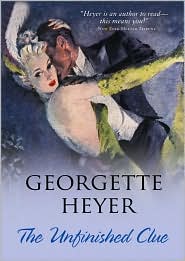The Unfinished Clue, by Georgette Heyer
Mar 23
2009

While Georgette Heyer is best remembered for her Regency romances, she also wrote a handful of superb detective stories. These mid-twentieth century British mysteries amply display Heyer’s gift for characterization and plotting (not to mention her wickedly sharp sense of humor), and are sure to please both fans of her romances and classic English mystery buffs.
As Heyer’s 1934 novel The Unfinished Clue opens, a group of people have traveled to the country home of Sir Arthur Billington-Smith for what can only be described as the weekend party from Hell. Sir Arthur is a domestic tyrant, and by the end of the gathering he has humiliated his wife, disinherited his son, and insulted nearly all of his guests. When Sir Arthur is fatally stabbed on Monday morning, the police find themselves with an overabundance of suspects. No one has much of an alibi, and everyone wanted him dead.
There are perhaps two dozen characters with speaking roles in The Unfinished Clue, and Heyer portrays less than a quarter of them as nice, normal human beings. Everyone else is deliciously, hilariously awful, from Sir Arthur’s gold-digging mistress to the nosy vicar’s wife to Sir Arthur himself, who comes across as an excellent candidate for murdering. In the hands of a lesser author, this parade of nutjobs might be too over-the-top, but Heyer’s deft pen keeps most of her characters and situations plausible. There are a few notable exceptions (including a massively self-absorbed cabaret dancer who hopes to become Sir Arthur’s daughter-in-law), and a slightly rushed—but still charming!—romantic subplot, but these little aberrations from reality just serve to remind readers that this is pure fiction and meant to be enjoyed.
A word of warning: The Unfinished Clue is a product of its time, and therefore features some broad clichés about foreigners and the lower classes. It is no worse than most of the mysteries written during this period (and far better than some*), but sensitive readers take heed.
*Seriously. There’s a very good reason the Agatha Christie book currently known as And Then There Were None is on its third title.
As Heyer’s 1934 novel The Unfinished Clue opens, a group of people have traveled to the country home of Sir Arthur Billington-Smith for what can only be described as the weekend party from Hell. Sir Arthur is a domestic tyrant, and by the end of the gathering he has humiliated his wife, disinherited his son, and insulted nearly all of his guests. When Sir Arthur is fatally stabbed on Monday morning, the police find themselves with an overabundance of suspects. No one has much of an alibi, and everyone wanted him dead.
There are perhaps two dozen characters with speaking roles in The Unfinished Clue, and Heyer portrays less than a quarter of them as nice, normal human beings. Everyone else is deliciously, hilariously awful, from Sir Arthur’s gold-digging mistress to the nosy vicar’s wife to Sir Arthur himself, who comes across as an excellent candidate for murdering. In the hands of a lesser author, this parade of nutjobs might be too over-the-top, but Heyer’s deft pen keeps most of her characters and situations plausible. There are a few notable exceptions (including a massively self-absorbed cabaret dancer who hopes to become Sir Arthur’s daughter-in-law), and a slightly rushed—but still charming!—romantic subplot, but these little aberrations from reality just serve to remind readers that this is pure fiction and meant to be enjoyed.
A word of warning: The Unfinished Clue is a product of its time, and therefore features some broad clichés about foreigners and the lower classes. It is no worse than most of the mysteries written during this period (and far better than some*), but sensitive readers take heed.
*Seriously. There’s a very good reason the Agatha Christie book currently known as And Then There Were None is on its third title.
Posted by: Julia, Last edit by: Julianka
No new comments are allowed on this post.
Comments
No comments yet. Be the first!